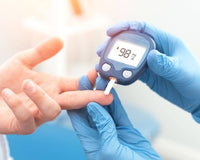Are Shingles And Herpes The Same?
Herpes and shingles are common conditions often mistaken for each other because of their similar names and symptoms. Herpes is a sexually-transmitted infection that often results in the appearance of cold sores. Shingles, on the other hand, is not an STD. Shingles is caused by reactivation of the virus that causes chickenpox and can result in pain and the appearance of an uncomfortable rash. In the following article we discuss the differences between herpes and shingles.
What Is Herpes?
Herpes is a common virus caused by infection from the herpes-simplex virus. An infection of herpes can produce sores on the genitals, buttocks, inner thighs, mouth, lips, and gums. More than half of Americans have oral herpes and roughly 1 in 6 have genital herpes. While sometimes painful and irritating, herpes does not usually cause serious or long-term health complications.
There are two types of herpes virus: herpes-simplex virus type 1, commonly referred to as oral herpes, and herpes-simplex virus type 2, or genital herpes.
What Is Herpes Zoster?
Herpes zoster is an acute infection usually referred to as shingles. Often confused with genital and oral herpes, herpes zoster is an acute viral infection that is caused by reactivation of the varicella-zoster virus. One of the many viruses known to be related to herpes, the varicella-zoster virus causes shingles and chickenpox. Infection of herpes zoster often causes a mild rash and the appearance of small blisters on the skin.
What Is Shingles?
Shingles is the common name for herpes zoster. Shingles is caused by acute infection of the varicella-zoster virus. In most cases, shingles is the result of a reactivation of the varicella-zoster virus, which causes chickenpox. After a person is infected with chickenpox, it is common for the virus to remain dormant in cells for many years. Most people who are infected with the varicella-zoster virus experience only a single episode of shingles later in their life, however, it is possible to have shingles more than once.
It is possible to be infected with herpes zoster through direct contact with a virus carrier. If someone is infected with herpes zoster, it is likely they will develop chicken pox first, and then shingles later in their life.
Are Shingles And Herpes The Same?
Although they are often mistaken for one another due to their similar names, herpes and shingles are actually not the same. Herpes, both oral and genital, is a sexually transmitted disease caused by infection from the herpes-simplex virus. Those infected with herpes often develop blisters and cold sores. Shingles is caused by a reactivation of the varicella-zoster virus and usually coincides with the appearance of a painful rash on the skin.
Is Shingles An STD?
A sexually transmitted disease (STD) refers to any disease transmitted through oral, anal, or vaginal sex. Shingles is often thought to be a sexually transmitted disease because of its relation to the herpes. Unlike herpes, shingles is not usually spread through sexual contact. A person with shingles can spread the virus when it is still in its blister phase. Shingles blisters are filled with fluid which contains particles of the shingle virus. The virus can be spread through direct contact with blisters or by inhaling virus particles mixed with the air.
Herpes Symptoms
The most common symptoms of herpes include the appearance of ulcers, blisters, and scabs on various areas of the body. These scabs can develop and break, resulting in pain and itching. Most symptoms are not serious and do not require medical attention. The symptoms of herpes usually differ depending on where the virus resides. The symptoms of genital herpes may be different from those of oral herpes.
Shingles Symptoms
Shingles can be a very painful condition that causes an uncomfortable rash. Symptoms of shingles can appear anywhere on the body, but are most likely to appear as a single stripe of blisters that wraps around the torso. Shingles can also cause a painful rash on one side of the face, fever, chills, headache, and upset stomach.
Herpes Vs. Shingles Treatment
Genital and oral herpes and shingles are all often treated through a combination of prescription medications and home remedies like warm baths. It is uncommon for herpes to cause significant pain, however, shingles can sometimes produce a burning sensation and a severe rash. Those with serious cases of shingles may find more extensive treatment options like anticonvulsants and tricyclic depressants helpful.
Treatment For Herpes
Although there is no known permanent cure for herpes, there are plenty of ways to manage infection and mitigate symptoms. Prescription medications such as acyclovir are designed to eliminate cold sores and help heal herpes. Changes in your lifestyle and habits can also help mitigate symptoms. Taking daily warm baths, wearing loose clothes, and keeping the genital area dry can help bring healing and prevent outbreaks of sores. Common herpes medications include acyclovir, valacyclovir, and famciclovir.
Treatment For Shingles
Shingles generally last for anywhere between two and six weeks before improving and disappearing. Treatment options for shingles are very similar to those for genital and oral herpes. The prescription medications acyclovir, valacyclovir, and famciclovir can help alleviate symptoms of shingles. If shingles cause severe pain, it may be wise to use anticonvulsants, tricyclic antidepressants, and numbing agents to alleviate pain.
Are Herpes And Shingles The Same?: Summary
Herpes and shingles are common conditions often mistaken for each other because of their similar names and symptoms. Herpes is an sexually-transmitted infection that often results in the appearance of cold sores. On the other hand, shingles is the common name for herpes zoster, an acute viral infection that causes rash, pain, and blistering.
Shingles is caused by a reactivation of the same virus that causes chicken pox. Although they are different conditions, the treatment options of herpes and shingles are very similar.








